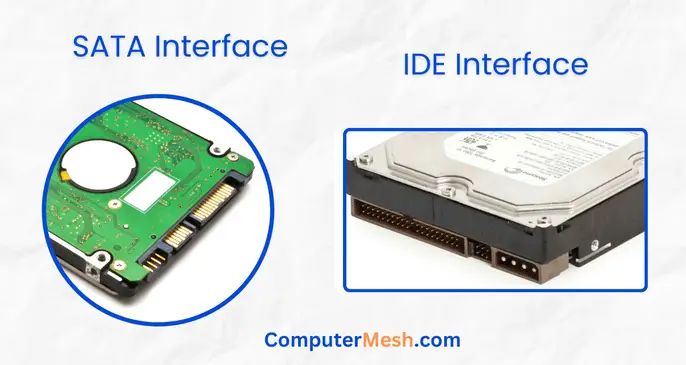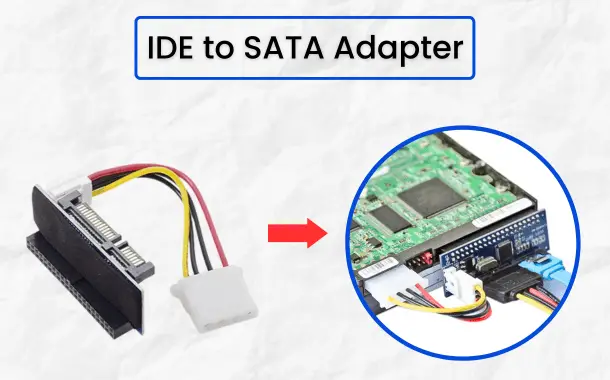Can you use a Laptop HDD In Desktop PC? & How?
Many users have both a laptop and a desktop computer, and sometimes, they may want to upgrade their desktop’s hard drive with the one from their old laptop. This raises the question:
Can you use a Laptop Hard drive in a Desktop?

The simple answer is yes; you can use a laptop HDD on a desktop computer. You may think that laptop hard drives are different from desktop ones, but in reality, they are smaller and lighter versions of the desktop hard drive. Both use the same basic technology and components to function.
Today, I will teach you how to use the hard disk of a laptop on a desktop computer. In order to use a laptop hard disk in a desktop, you need to consider some of the essential factors. Let’s look at those:
Factors Decides How Laptop Hard Drive Work on a Desktop
1. Physical Size
Due to space concerns, most laptops use a 2.5-inch form factor of HDD, while desktops popularly have a bigger 3.5-inch form factor as desktops don’t have limits on space.
So, for desktops, hard drives are designed to fit into the 3.5-inch wide bay drive.
But since a 2.5-inch hard drive is noticeably smaller than a 3.5-inch drive, you need to make sure to accommodate the compact 2.5-inch laptop hard drive nicely, mainly where space is limited or in a small form factor PCs.
Also, if the 2.5-inch space tray dedicated to SSD is free, you can try it there.
Otherwise, you may need a 2.5 HDD mounting bracket adapter to secure the laptop drive in place. The mounting bracket adapter is just a small piece of cage-like metal with screw holes on the sides that helps to hold your 2.5-inch drive in position inside the PC case.
2. Power Connector
Laptop hard drives can easily connected to desktop motherboards using connectors depending on the type.
For this, you have to identify whether your laptop’s HDD uses a SATA (7-pin) or IDE connection (30-45 pinholes) and then whether your desktop’s motherboard has the corresponding connector.
Most modern hard drives sold use the SATA standard to connect, as it is the latest and fastest technology. But if you have a particularly old disk, it may use IDE. As you see in the picture below, the differences are notable.

In this way, if your laptop drive uses a SATA, and your desktop also has a SATA connector available, then you’re good to go with SATA cable.
But if your HDD uses an old IDE interface and your desktop only has a SATA cable, you will need a converter/adapter.
Because SATA and IDE connectors are not compatible with each other, a IDE to SATA adapter enables you to connect an IDE hard drive to a non-IDE motherboard.

Moreover, you can also use a hard drive via a docking station (an expensive option) or a USB enclosure. These are external cases or docks that include a built-in interface converter that allows you to connect a hard drive to the desktop externally, and yes, it becomes a kind of external hard drive after doing so.
3. Speed
Speed is another factor differentiating between both hard drives. Hard drives in laptops usually spin at 5,400 rpm and run at slower speeds than their desktop counterparts, which have a higher rpm of 7,200 or even more sometimes like with SAS interfaces.
When your computer reads and writes data, the platters in the drive spin, and the faster it spins, the faster your computer can open and access files.
Therefore, if you plan to go further with your laptop’s drive, you won’t experience speeds as fast as those 7200 rpm desktop HDDs, which is a slight gap though.
4. Performance
Apart from speed of the hard drive, another factor to consider is the overall performance. Laptop drives are designed for portability, so they may not have as high-performance levels as desktop hard drives.
Desktop HDDs have larger cache memory, storage sizes, and faster data transfer rates, making them more ideal for heavy usage such as video editing or to quickly load games and other programs.
And if we talk about the biggest advantages of laptop hard drives, i.e., low power consumption and sturdiness, they are able to withstand higher levels of vibration and shock.
Connecting Laptop Hard Drive With Desktop PC
Now that you have a better understanding of the differences between laptop and desktop hard drive, let’s talk about how to connect a laptop hard drive with your desktop.
A. Internal Connection
First, make sure both your laptop HDD and desktop motherboard are compatible in terms of interface. As mentioned earlier, if they both have SATA interfaces, then you’re good to go without any additional converters.
However, if the laptop has an IDE drive, then you can use an adapter like the one mentioned earlier (IDE to SATA adapter) to make the connection possible.
The steps are:
- Of course, the first thing you need to do is remove the hard drive from the laptop by unscrewing the case carefully.
- Turn off and unplug your desktop.
- Open the case of your PC by removing the screws on the side panel.
- Locate an available SATA port on your motherboard – it will be a small rectangular slot with a thin, L-shaped connector inside.
- Connect one end of the SATA cable to the SATA port on your HDD and the other end of the SATA cable to the available SATA port on your desktop motherboard.
- Secure both ends of the cable by pushing it in until it clicks into place.
- If using an adapter, connect the IDE connector of the adapter to the 40-pin IDE port on the back of the IDE HDD then connect one end of the SATA data cable to the SATA port on the adapter.
- Now, connect the SATA power cable to the power port on the adapter. Ensure that the IDE HDD is getting power.
- Locate an available SATA port on the motherboard.
- Connect the other end of the SATA data cable to an available SATA port on the motherboard.
- Close the case of your PC and screw back in all removed screws.
- Plug in and turn on your PC.
Remember – SATA data cable and SATA power cable is different from each other.
Your desktop should now recognize your laptop’s hard drive as an additional storage device.
B. External Connection
Next, if you like to keep your laptop HDD as an external drive, then the easiest way to connect it to your PC case is through a USB enclosure or docking station. This method is also helpful if you want to access files from multiple devices without having to connect them each time physically.

- Purchase a USB enclosure or docking station for your laptop HDD. Make sure to choose the correct type that fits your specific HDD size (2.5″ or 3.5″) as well as supporting the interface.
- Locate an available USB port on your PC case or laptop.
- Connect the USB cable from the enclosure or docking station to your PC or laptop’s type A USB port.
- Insert your HDD into the enclosure or docking station, following any accompanying instructions on how to do so correctly.
- Turn on and connect the power supply for the enclosure or docking station, if necessary.
- Wait for your desktop to recognize the external device. It should appear as an additional storage device.
You can now access and transfer files from your laptop’s HDD, just like any other USB device. Once finished, properly eject the external device from your PC case before unplugging it to avoid data loss.
After connecting the hard drive, you will need to make sure your computer recognizes it. Go to “Disk Management” in Windows to check if the hard drive is detected. You can also configure through BIOS/UEFI.
It’s important to note that when connecting a laptop hard drive with a desktop computer, it will only function as a secondary storage device but not as the primary bootable drive. This means you cannot install an operating system on it and use it as your primary storage device for your desktop.
If there are already some partitions and stored data on the hard drive, but you don’t want to keep them, you can format the hard drive. To do this, right-click on the drive and select “Format.” Make sure to choose the correct file system, depending on your needs.
Formatting a hard drive will erase all existing data, so make sure you have backed up any important files before proceeding.
Do you know – There is also an external converter for SATA, a SATA to USB adapter to connect the laptop HDD externally through USB ports available on your PC case type.
Lastly, if you want to connect your laptop’s drive wirelessly to your desktop, you can use a network-attached storage (NAS) device. This allows you to access and transfer files from your HDD over a Wi-Fi or Ethernet connection.
Final words
This post answers the question,” Can a laptop’s hard drive work on a desktop?” with facts and tips.
So next time, for any reason, you want to reuse the laptop hard drive that is not damaged, follow the steps mentioned above, and you will be fine to use HDD without any problems or rather buying an external drive.
Remember that while laptop and desktop hard drives may have some differences, they both serve the same purpose – to store your data and keep it safe.
[Related]
